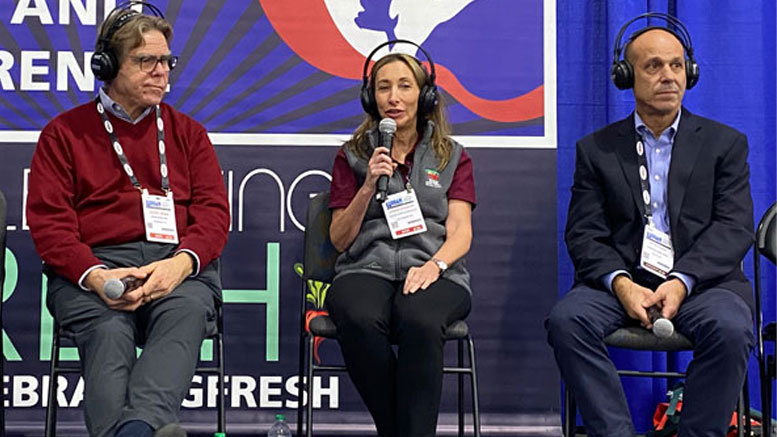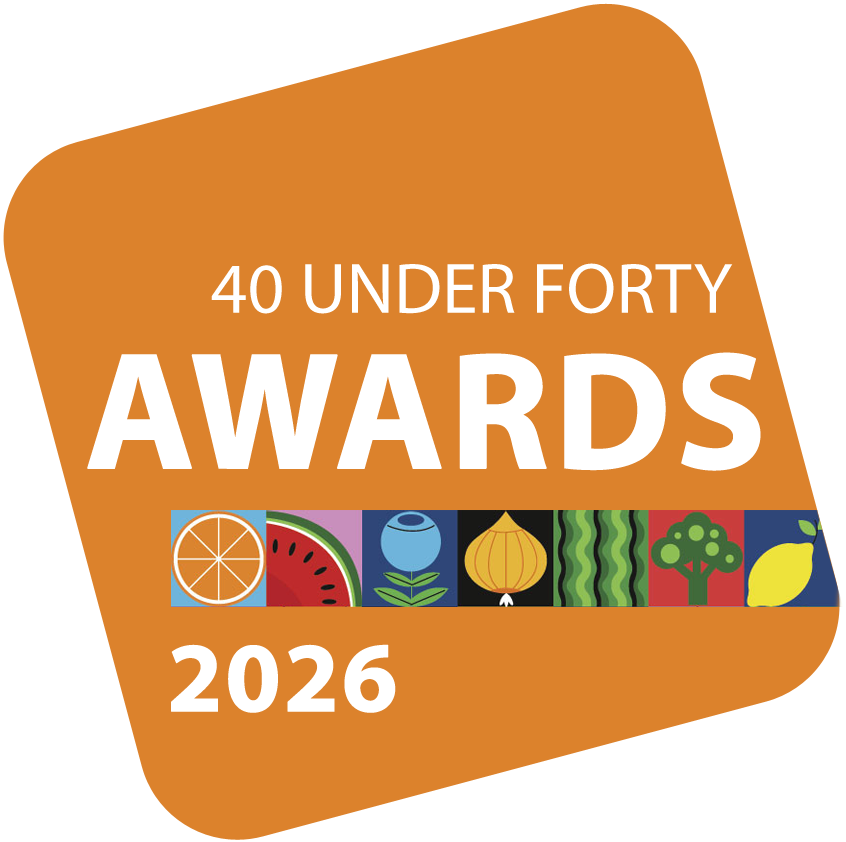New York Produce Show Educational Sessions Feature Produce Industry Leaders
December 20, 2023 | 11 min to read
During the New York Produce Show on December 6, industry leaders gathered to discuss the promising future of indoor-grown produce in retail, noting significant market growth driven by taste and freshness. Insights from the Deep Dive into Consumer Thinking panel highlighted the importance of consumer education and engagement. Additionally, sustainability efforts and distribution challenges were addressed, emphasizing cooperation and innovative strategies among retailers and wholesalers to adapt in a rapidly evolving market.

Five educational sessions were spotlighted on a corner stage on the Javits Center trade show floor during the New York Produce Show (NYPS) Dec. 6. Each topic featured a panel of industry leaders, who shared their insights.
INDOOR-GROWN PRODUCE
The first session, on the retail future of indoor-grown produce, drew a standing-room-only crowd. Moderated by Tom Stenzel, executive director of the Controlled Environment Agriculture Alliance, the panel included Irving Fain, chief executive and founder, Bowery; Ross Farnsworth, Wakefern vice president of floral and produce; Viraj Puri, chief executive and founder, Gotham Greens; and Paul Sellew, chief executive and founder, Little Leaf Farms.
Controlled environment agriculture (CEA) — both vertical farms and greenhouses — is booming. In fact, says Sellew, CEA leafy greens are about 24% of the market share in the Northeast.

MARTY WHITACRE/PRODUCE BUSINESS PHOTO
The speakers emphasized the sector, which is mostly leafy greens (although there are peppers, flowers, cucumbers and berries being grown), represents true growth and not a cannibalization of field-grown produce. “We see this as being incremental, which is critical to retail growth,” says Farnsworth. “It taps into more frequency of purchase or a new customer.”
Farnsworth adds Wakefern is approaching CEA accounting for 10% of market share.
That growth is also leading to stronger grower-retailer partnerships, Fain says, adding Bowery retailers are asking “how can we work together with you to build this new category?”
“A large retailer recently said their view is the produce grown indoors will ultimately be a bigger opportunity than organic produce is for them today.”
The drawing card is taste and longer shelf life. “We’re cutting, delivering and getting product into the market in 24 hours,” Sellew declares. And there’s less risk with the tight supply chain that many of these companies embrace.
“There’s just so many benefits that indoor can provide against outdoor, and when you see that outdoor has an increasing set of challenges in front of it, this just makes all the more sense,” adds Fain. “This is the next step beyond organic.”
“Change takes time,” he adds, “but fast-forward five to 10 years, and the growth rate will accelerate, not slow down.
DEEP DIVE INTO CONSUMER THINKING
Retailers have a front-row view of how consumers shop. Five shared their insights via a Deep Dive into Consumer Thinking Panel on the Industry Insights Stage at the NYPS. Moderated by Wendy Reinhardt Kapsak, president and chief executive of the International Food Information Council, the panel followed a research update on current consumption by Benjamin Campbell, associate professor at the University of Georgia.
Mike Roberts, vice president of produce operations at Harps Food Stores, started by saying he believed consumer education can boost the intake of produce, citing the retailer’s long partnership with Produce For Kids.
Martha Hilton, vice president of produce and floral at Wegmans Food Markets, cited flavor, getting creative in communicating online, and working to put more fresh produce in the hands of children.
Consumer engagement — from the produce department to check out — was suggested by Kit Britt, produce buyer for The Turnip Truck Natural Market, and the convenience of produce, such as fresh-cut fruit, was named by Alan Hartline, owner of Kingma’s Market.
Finally, the importance of training pickers in quality and freshness when choosing fruits and vegetables for online shoppers is essential for maintaining this customer and repeat purchases, says Jim Hancock, vice president divisional merchandise manager for produce and floral at Sam’s Club.
MERCHANDISING SUCCESS STORIES
In the seminar, Merchandising Success Stories, representatives of organizations that support retailers in boosting sales provided examples of how store displays and supported programs can jump-start produce department sales.
The panel, moderated by Vic Savanello, vice president of merchandising, sales and business at FreshPro Food Distributors, West Caldwell, NJ, included Cynthia Haskins, president and chief executive of the New York Apple Association, Fishers, NY; Allison Myers, regional merchandising director, Chilean Fresh Fruit Association/Northwest Cherries, Washington State Fruit, Overland Park, KS; Meg Buchsbaum, East Coast retail account manager, National Mango Board, Orlando, FL; and Ross Johnson, international marketing director, Idaho Potato Commission.

From the perspective of the New York Apple Association, associating product and place is critical. Haskins pointed out the New York Apple Association rebranded seven years ago and launched new poly bags for Empire State apples. The point was to ensure consumers who walked stores could identify New York apples.
Myers says last winter the Chilean Fresh Fruit Association ran a bin program with Jewel/Osco. “We needed to do something to make a splash,” she says.
Meg Buchsbaum says mangos, which have been an up-and-coming fruit nationally, provide opportunities for retailers who emphasize the qualities of the fruit.
“We want to be able to reach everybody,” she says. “When in-store, we want to be able to talk about nutrition, we want to be able to talk to children. One of the greatest things we do is talk with dietitians in stores.”
Another opportunity is online demos with chefs, Myers emphasized.
Buchsbaum noted merchandising is important to bring promotions together, with multiple displays and cross-selling opportunities.
Some retailers make a concerted effort to spread the mango story. Buchsbaum noted the National Mango Board’s national mango retailer of the year was Weis Market. The organization has maintained a long relationship with the Sunbury, PA, supermarket chain, which led to a multi-faceted marketing and merchandising program. In one initiative, the board created and distributed hats that said, “Weis Loves Mangos.”
Johnson pointed out the Idaho Potato Commission has a field staff that meets with retailers directly, and the commission has taken a deep dive into data analytics in the last five years. “We go into a retailer and we discuss how their categories are performing,” he says. “Then, at the same time, we take the opportunity to say, here’s how you compare to the rest of the market, and that is usually eye-opening for them.”
Price gains last year, and the fact that Idaho had a short crop, made things more difficult as the commission staffers sat down with retailers who wanted to lap sales from the year before.
However, using data analytics and store discussions, commission experts suggested putting some promotional weight against the 10-pound bag of Idaho potatoes, given that the purchase price for the 10-pound package this year is pretty much the same as it was for a 5-pound bag last year. By pushing the bigger package, the retailer can increase sales, and Idaho growers can enjoy greater volume.
The potato category has gotten a boost from specialty, mostly smaller spuds, which have gotten a lot of attention from consumers. Johnson says the reality is small specialty potatoes don’t cannibalize the core category. Consumers consider and purchase on a different basis. So, the commission works with retailers on consumer outreach to make the most of what isn’t an either/or, but and/also situation that can lead to more potato sales overall.
SUSTAINABILITY IN ACTION
In the seminar, Sustainability in Action, moderator Jill Overdorf, founder of The Produce Ambassador, sought opinions on the matter from Tara Smith-Vighetti, president of sales, Smith Farm, Presque Isle, ME; Stevie Shandler Maier, business development and sustainability director, Shapiro-Gilman-Shandler Co./Grubmarket Inc., Los Angeles; John Paap, manager, Jac. Vandenberg, Tarrytown, NY; and Steve Jennings, stakeholder relations/brand lead, health and sustainability, Giant Foods, Landover, MD.
As it considers sustainability, Smith Farms has committed to developing a network of sustainable farm enterprises, says Smith-Vighetti. However, the company doesn’t think about sustainability in terms of preservation.
“It requires active maintenance,” she says, “If I have a tractor, and I want it to last a long time, and I park in the garage, I might preserve it, but if I really want to sustain it, most likely I’m going to have to do something.”

DEAN BARNES/PRODUCE BUSINESS PHOTO
For his part, Paap says sustainability in the agricultural industry is an element in a larger dynamic, in that preserving the environment is a critical part of preserving the business itself, taking into mind the demands of consumers and the social cross-currents generated by worries about the environment.
Recipient of the PRODUCE BUSINESS Sustainability Retailer of the Year award in 2023, Giant has developed a more robust program over time that marries sustainability with its larger mission of serving people in its market area. As such, the company has invested resources, including personnel dedicated to sustainability and related issues that the company regards as interrelated.
Giant set goals for its sustainability efforts that encompass a range of issues, such as food waste reduction and the elimination of plastic to ensure the company continues to make progress.
Sustainability in packaging has been a topic that has been especially fraught over the past few years. The turmoil has tended to stir different feelings about materials such as plastic, as consumers weigh environmental, health and financial concerns.
Paap says, “In our minds, plastic is not a sustainable solution. What we’ve done is really look at natural resources — material that we can source responsibility from the Earth and can return to the Earth.”
The pursuit of that goal hasn’t been easy. Yet, despite some difficulties encountered in the development and even discovery of more sustainable packaging and precursor material, the need to move forward has become obvious, he says.
Maier says when it comes to addressing sustainability, “there is no handbook.”
Shapiro-Gilman-Shandler has had to figure out how to make progress within the context of its business. One way it has done so has been to ramp up its approach to waste, as it seeks to deliver as much as it can in the way of food donations.
Smith-Vighetti says Smith Farms has a comprehensive approach that includes everything from the use of packaging and cooling to water resources and land management.
From the strategic standpoint, she says, the company is looking at “how our business models are designed and our partnership and our current operations and how they integrate.”
The next items on the Smith Farms agenda are technology and its application. “What can we do better, faster, cheaper and more efficiently?” she says.
Smith-Vighetti emphasized the road forward requires market support.
Cooperation was a theme of the seminar. Paap, for instance, pointed to the sharing of innovations and practices across the produce sector, including with competitors.
DISTRIBUTION CHALLENGES, OPPORTUNITIES
The Industry Insights stage also featured a panel of wholesalers — John Vena, president of John Vena Inc., Philadelphia; Carole Shandler, general manager, Shapiro-Gilman-Shandler Co., Los Angeles; and Matthew D’Arrigo, president, D’Arrigo New York — who tackled the topic of distribution challenges and opportunities. Kristen Park, Cornell University, moderated the panel, and also shared information on a survey of existing terminal produce markets underway by the U.S. Department of Agriculture.
All three panelists said the bottom line is continually assessing your market and your customers’ needs.
“We’ve spent a lot of time thinking about what customers want,” Vena says, and his company shifted from commodities into greenhouse produce and ethnic produce “because no one else was.” It was a “small-scale winner” initially, but now the lines include approximately 600 items a day.

SUSAN CROWELL/PRODUCE BUSINESS PHOTO
John Vena Inc. customers are roughly half foodservice and half retail, Vena says, so the company has also expanded services, such as ripening and repacking.
The model at New York’s Hunts Point Produce Market is unique, D’Arrigo notes, and it works because of the huge number of retail and foodservice outlets in the metropolitan area. Both D’Arrigo and Shandler say independent retailers prioritize long-term partnerships over short-term gains.
Logistics and transportation remain challenges. For imports, unpredictable container arrival times continue to frustrate wholesalers (“Shipping lines drive us crazy,” Vena declares.). Shandler says although they’re based in California, they have shipped product to the East Coast and trucked it across the country to improve reliability of product. But, she adds, “the whole western side of this country is just a mess when it comes to tracking logistics.”
Trucking challenges, however, have triggered opportunities, D’Arrigo says, bringing some business back to wholesalers from customers who are ditching their own trucks.
Relationships with exporters are also slowly evaporating, as international companies get closer to the grower and establish U.S.-based companies, Vena adds.
Balance is the key, Shandler says. For example, sourcing both domestic and imported products; brokering; consolidating product. “We’re not geared to sell less of anything, we’re geared to sell more.”
And that’s the hot issue, D’Arrigo says. “All I think about is how to sell more produce.”
The 14th annual New York Produce Show and Conference (NYPS) opened Dec. 5. The event had a record audience of more than 5,000 executives attending the one-day trade show and three co-located events. There were 350-plus exhibiting companies and a record of 41 sponsors. The New York Produce Show is organized by PRODUCE BUSINESS and the Eastern Produce Council.
SAVE THE DATE!
Mark your calendar for next year’s New York Produce Show and Conference: Dec. 10-12, 2024.
And exhibitors, book your booth now, as there’s a limited time to maintain the current booth rate. Visit www.nyproduceshow.com/exhibit2024 or talk to your sales representative before Jan. 12 to lock in the 2023 rate!

